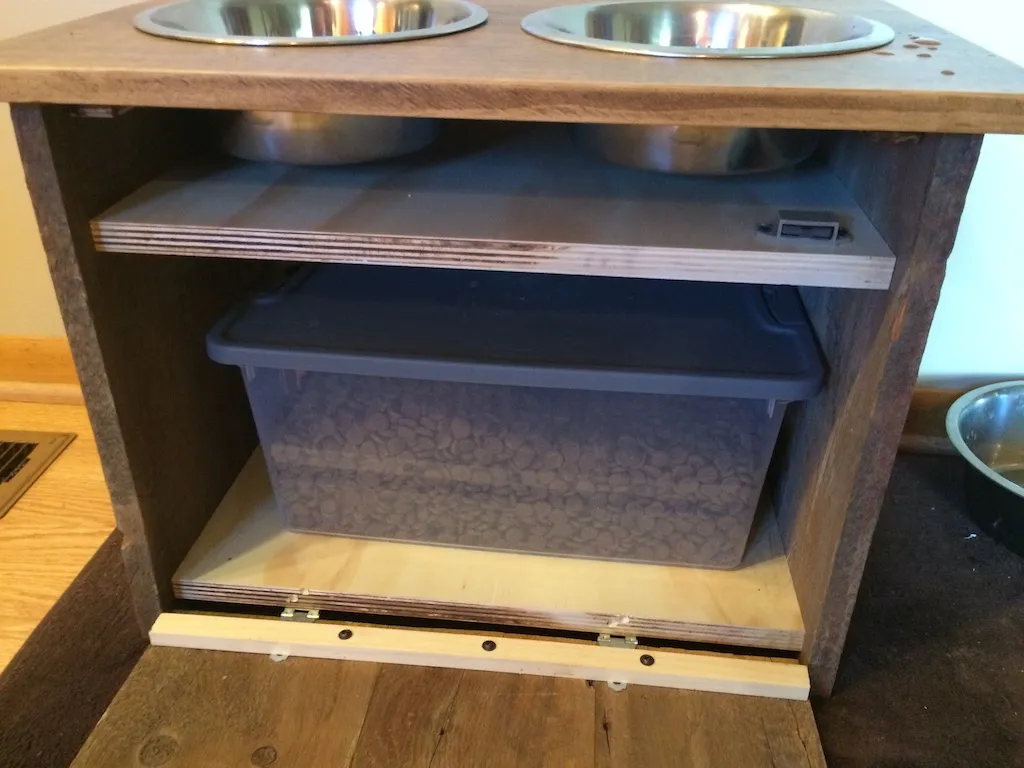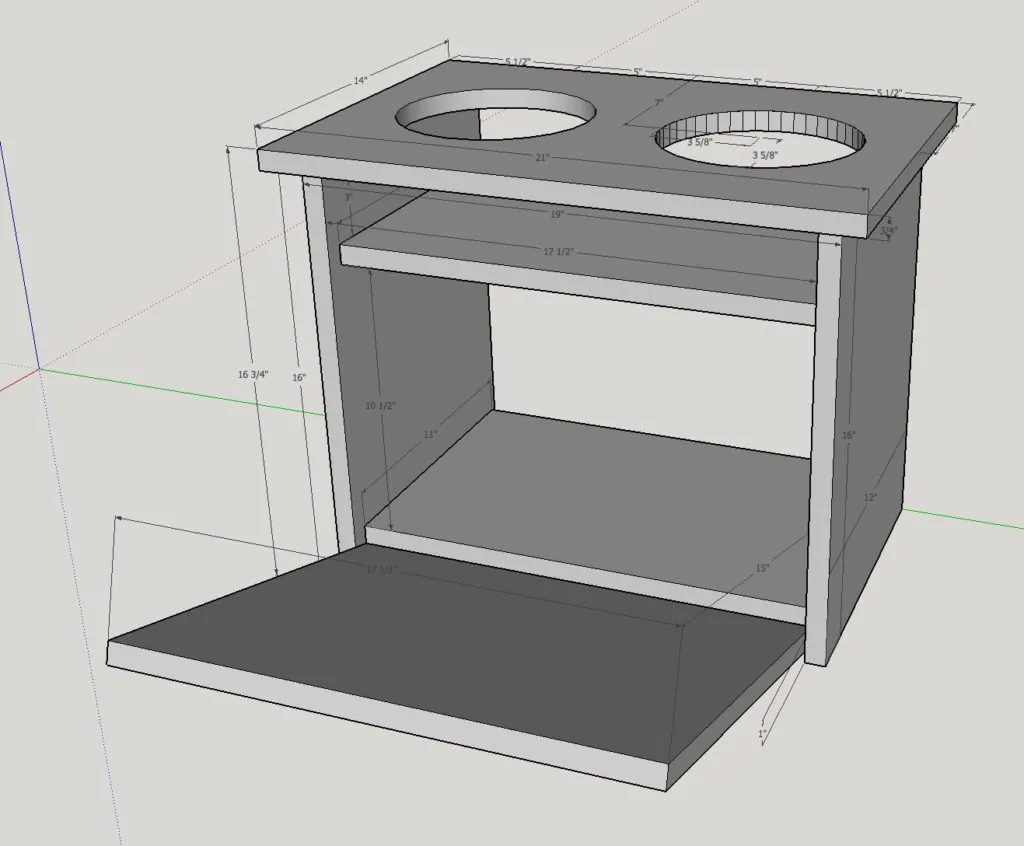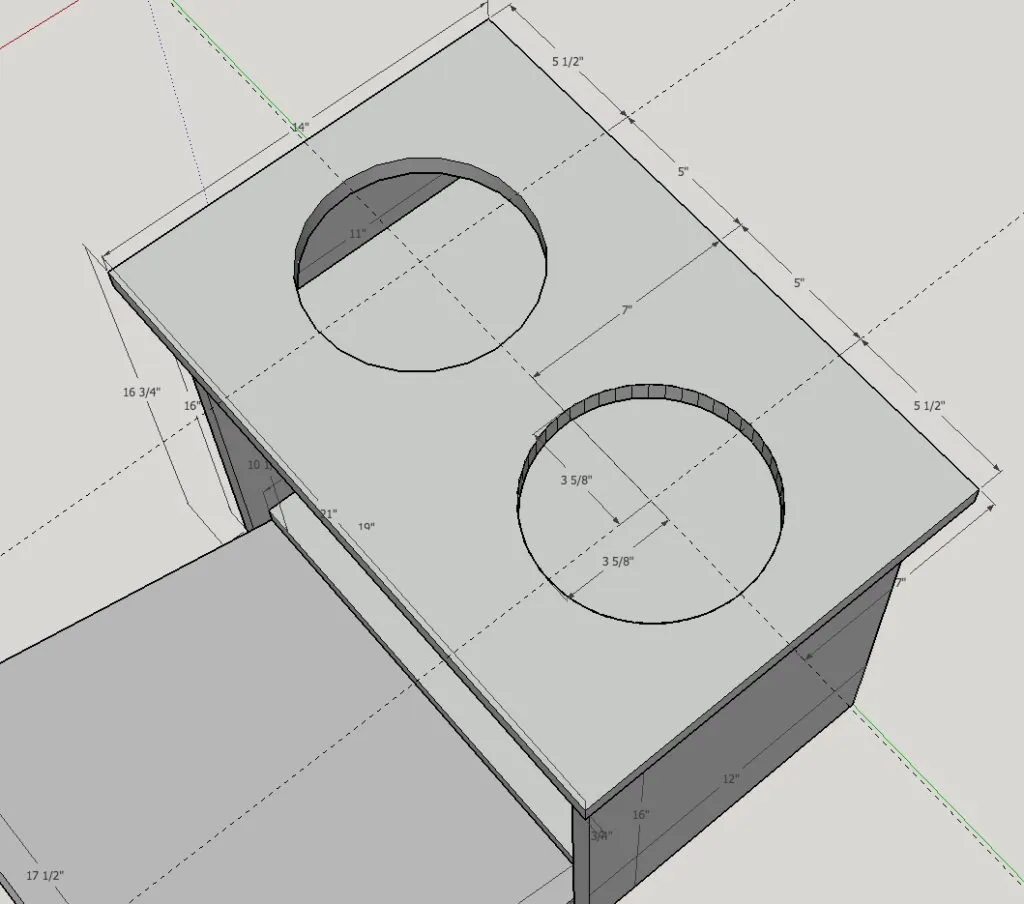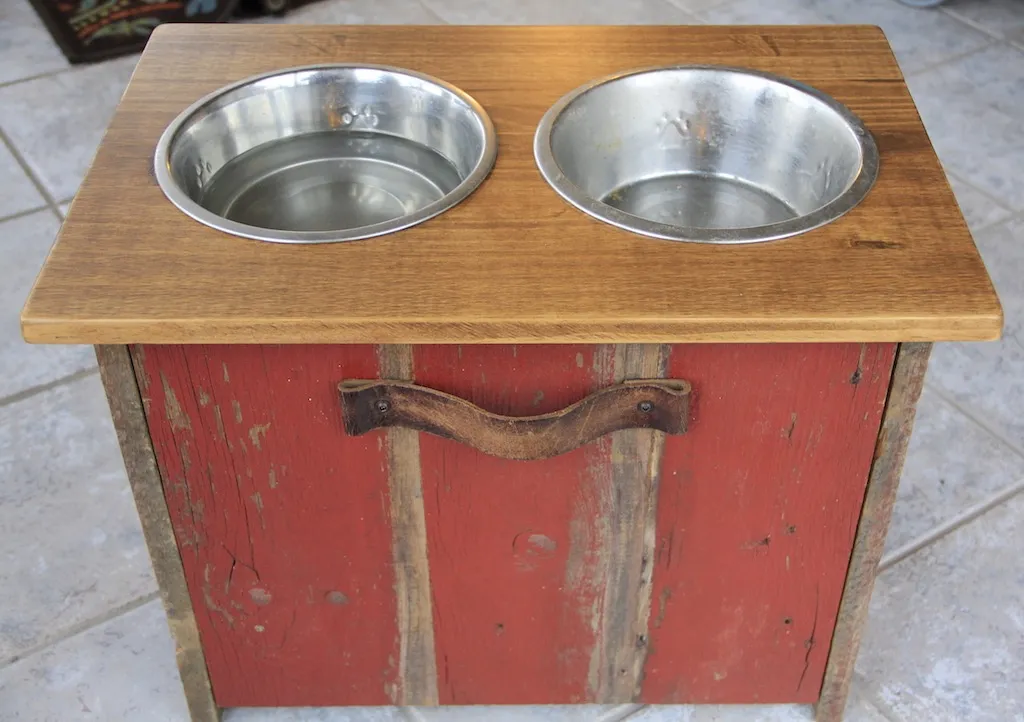For years, many dog owners, including myself, have settled for separate food and water bowls placed directly on the kitchen floor. While functional, this setup often lacks aesthetic appeal and convenience, especially for taller dogs who have to bend significantly to eat and drink. My wife and I, owners of a magnificent 100-pound Golden Doodle, observed this firsthand. We experimented with various makeshift risers, from popcorn tins to 5-gallon buckets, trying to find the ideal height for her comfort. These temporary solutions, though effective in elevating her bowls, were far from attractive and certainly didn’t complement our home decor. This ongoing struggle sparked the idea for a permanent, elegant, and practical solution: an elevated Dog Food And Water Bowl With Storage built right into its design.
This article details how you can construct your own custom dog feeding station, offering both ergonomic benefits for your canine companion and a tidy, accessible storage solution for their food. Forget unsightly bins and scattered kibble; this DIY project is designed to enhance both your dog’s mealtime experience and your home’s organization. Before diving into the build, it’s worth understanding why such a setup is more than just a home improvement project – it’s an investment in your dog’s well-being. For owners keen on their dog’s nutritional health, understanding what are some things dogs cant eat is crucial, even when focusing on optimal feeding solutions.
Why an Elevated Dog Food and Water Bowl with Storage is a Game Changer
An elevated dog feeder isn’t just about aesthetics; it offers significant health and practical benefits for both dogs and their owners.
Benefits for Your Canine Companion
- Improved Digestion and Posture: For larger breeds or older dogs with arthritis, bending down to eat and drink can be uncomfortable and even lead to strain on their neck and joints. Elevated bowls allow them to maintain a more natural posture, potentially reducing discomfort and aiding in smoother digestion. This can be particularly beneficial for preventing bloat, a serious condition in some deep-chested breeds, though veterinary consultation is always recommended for specific health concerns.
- Reduced Strain: Dogs with mobility issues or specific medical conditions often find it easier to access food and water from a raised position, making meal times less strenuous and more enjoyable.
- Cleaner Eating Area: Elevated bowls can help reduce the amount of food and water spilled on the floor, as dogs are less likely to drag their faces or paws through their meals. This contributes to a more hygienic feeding environment and less cleanup for you.
Benefits for Dog Owners
- Enhanced Organization and Tidiness: One of the biggest advantages of a dog food and water bowl with storage is the integrated compartment. This eliminates the need for bulky, separate food bags or bins cluttering your space. Everything your dog needs for mealtime is neatly contained within one attractive unit.
- Convenient Access: A well-designed storage compartment allows for easy refilling of bowls and quick access to a fresh supply of kibble without having to move the entire station or the bowls themselves.
- Pest Control: Storing dog food in a sealed compartment within the feeder can help deter pests like ants, mice, or other critters, keeping your dog’s food fresh and safe.
- Aesthetic Appeal: Unlike a plastic storage bin or an old bucket, a custom-built elevated feeder can be designed to match your home’s decor, adding a touch of personalized charm to your pet corner.
Designing Your Custom Dog Feeding Station: Key Considerations
My overall design philosophy for this elevated dog food and water bowl with storage was simplicity and maximum functionality. Here are the core elements to consider:
- A Top with Two Holes: This forms the primary surface, holding two bowls – one for food and one for water.
- A Spill Partition: Positioned just below the bowls, this internal partition is crucial for catching any splashes or dropped kibble, keeping the stored food separate and dry.
- An Integrated Storage Compartment: This is where the magic happens, neatly stowing a significant amount of dog food.
- A Tilting Front for Easy Access: This feature is paramount. Many designs require you to lift out the bowls or remove the entire top to access the food storage. My design avoids this, allowing you to replenish food without disturbing your dog’s meal setup. The tilting front rests on the floor, providing a stable platform when you pull out the storage container, preventing the entire station from tipping. I considered a drawer, but a 15-quart container of food could easily destabilize a standard drawer design. For those who prioritize healthy food options for their pets, considering alternatives like homemade treats for dogs with no teeth or even homemade dog treats without peanut butter could be a great addition to their dog’s diet, stored conveniently nearby.
 elevated dog bowl station with extra food storage
elevated dog bowl station with extra food storage
Determining the Ideal Height for Your Dog’s Bowls
The height of your elevated dog feeder is perhaps the most critical dimension for your dog’s comfort. There isn’t a one-size-fits-all formula, as dogs vary widely in breed, size, and individual needs.
The best approach is to experiment. Place your dog’s current food dish on various temporary risers (books, sturdy boxes, etc.) and observe them as they eat and drink. The goal is to raise their food so they don’t have to bend their front legs or crane their neck excessively. They should be able to eat comfortably with their head level with their shoulders or slightly lowered.
My version is quite tall, specifically designed for a large dog. When planning your build, consider leaving a few extra inches in the storage area if possible. This offers flexibility in case you decide to use a different storage bin in the future or if your dog grows.
Sizing Up Your Storage: Bowls and Bins
This project begins with a practical foundation: the size of your chosen dog food storage bin and your dog’s food and water bowls.
You’ll need bowls with a distinct lip that can safely drop into the top of the stand. We opted for simple stainless steel bowls from Walmart, which required a 7.5-inch diameter hole. Stainless steel is an excellent choice as it’s durable, easy to clean, and hygienic.
The dog food storage container also came from Walmart – a straightforward plastic bin with a lid and locking handles. A 15-quart container was chosen for its generous capacity, storing enough food for extended periods, even when traveling. Whether you’re feeding kibble, or high-quality options like healthiest wet dog food or even specialized diets such as best wet dog food small breed, having ample, secure storage is key.
Once you have your bowls and storage container, you can finalize the dimensions for your personalized elevated dog food and water bowl with storage. Here are the dimensions I used for our large dog’s station, which you can adjust to fit your specific needs:
 elevated dog bowl station overall dimensions
elevated dog bowl station overall dimensions
The top of the station overhangs the main box by 1 inch on all sides. The bottom edge of the front door is set 1 inch off the ground.
 elevated dog bowl station top dimensions
elevated dog bowl station top dimensions
These specific dimensions were tailored for the dog bowls we utilized.
Materials You’ll Need for Your DIY Elevated Dog Feeder
Choosing the right materials is essential for durability and longevity, especially given its purpose as a dog food and water bowl with storage. This piece will inevitably encounter spills and general wear.
I used reclaimed barn wood for the sides and front, which added a rustic charm. For the top, an edge-glued pine panel provided a smooth and stable surface. The internal components were crafted from leftover pre-finished plywood scraps.
Considering the inevitable exposure to moisture and dirt, opting for reclaimed or recycled materials like old pallets, scrap decking, or inexpensive pine boards from a home improvement store is a practical choice. The key is to ensure the wood is properly treated. Be sure to either paint or seal the wood with a high-quality, waterproof finish such as polyurethane, or a durable paint. I applied Minwax aerosol satin polyurethane to the barn wood, and the top was stained with a gel stain before also being sprayed with Minwax satin poly.
I chose not to include a back panel since our station would always be placed against a wall. However, I allowed 1/4 inch of space at the back, just in case I decide to add one later. Adding a back panel can significantly enhance the stand’s stability and prevent lateral shifting, especially if your initial frame isn’t perfectly square.
 elevated dog bowl station with metal bowls made of reclaimed barn wood
elevated dog bowl station with metal bowls made of reclaimed barn wood
Step-by-Step Assembly Guide
Building this elevated dog food and water bowl with storage is a rewarding project that can be completed with basic woodworking tools.
- Constructing the Side Panels: I utilized pocket screws to securely attach the internal plywood pieces to the barn wood side panels. My barn wood happened to be 12 inches wide, which was perfectly suited for the depth of the storage container. If your chosen wood isn’t wide enough, you’ll need to glue a couple of boards together to create the necessary width for your side panels.
- Assembling the Front Door: The front panel required gluing three pieces of wood together. After squaring up the edges on a table saw, I used wood glue and biscuits to edge-glue the boards. For added strength, especially with softer, more brittle reclaimed wood, I attached two cross pieces to the back of the front door. Be mindful of their placement to ensure they don’t obstruct the door’s closing mechanism.
- Attaching the Hinges and Handle: For the tilting front, I used a pair of small strap hinges positioned at the bottom of the door. To maintain the rustic aesthetic, an old leather belt was repurposed into a stylish and functional handle. This leather handle was a fantastic addition, perfectly complementing the reclaimed wood.
- Securing the Top: To attach the top panel, I screwed four small blocks to its underside, aligning them with the side panels. I then pre-drilled horizontal holes in these blocks, allowing me to screw the top to the sides. This method offers great stability and the convenience of easy removal should you ever need to replace or refinish the top.
 elevated dog bowl station top attachment and door catch
elevated dog bowl station top attachment and door catch
Finishing Touches: Protecting Your Investment
Once your elevated dog food and water bowl with storage is assembled, the final step is to apply a protective finish. As previously mentioned, this piece will be exposed to spills and moisture, so a good sealant is crucial. Whether you choose paint, polyurethane, or another waterproof wood finish, ensure it’s applied thoroughly and allowed to cure completely before introducing your dog to their new feeding station. A quality finish will not only protect the wood but also make cleaning significantly easier, maintaining the station’s pristine appearance for years to come.
Conclusion
Building your own elevated dog food and water bowl with storage is a practical and rewarding project that offers numerous benefits for both you and your beloved canine companion. From improving your dog’s posture and digestion to keeping your home tidy and organized, this custom feeding station is a true game-changer. It eliminates the need for unsightly temporary solutions and replaces them with a durable, aesthetically pleasing, and highly functional piece of furniture. With careful planning, the right materials, and a bit of DIY spirit, you can create a custom feeder that perfectly suits your dog’s needs and complements your home. We encourage you to embark on this project and share your creations with our community.
